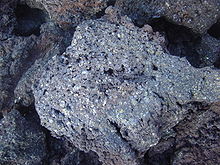
Picrite basalt or picrobasalt is a variety of high-magnesium olivine basalt that is very rich in the mineral olivine. It is dark with yellow-green olivine phenocrysts (20-50%) and black to dark brown pyroxene, mostly augite.
The olivine-rich picrite basalts that occur with the more common tholeiitic basalts of Kīlauea and other volcanoes of the Hawaiian Islands are the result of accumulation of olivine crystals either in a portion of the magma chamber or in a caldera lava lake.[1] The compositions of these rocks are well represented by mixes of olivine and more typical tholeiitic basalt.
The name "picrite" can also be applied to an olivine-rich alkali basalt: such picrite consists largely of phenocrysts of olivine and titanium-rich augite pyroxene with minor plagioclase set in a groundmass of augite and more sodic plagioclase and perhaps analcite and biotite.
More generally the classification of fine grained rocks recognises a group known as 'picritic rocks' that are characterised by high magnesium content and less than 45% SiO2. Having high Mg content they fit in the TAS classification system only at the lowest levels of Si02 and Na2O + K2O. They include picrite, komatiite and meimechite.
Picrites and komatiites are somewhat similar chemically (defined as >18% MgO), but differ in having 1 to 2% total alkalis and <1% total alkalis respectively. Komatiite lavas are products of more magnesium-rich melts, and good examples exhibit the spinifex texture.[2] They are largely restricted to the Archean. In contrast, picrites are magnesium-rich because crystals of olivine have accumulated in more normal melts by magmatic processes.[citation needed]
Picrite basalt is found in the lavas of Mauna Kea and Mauna Loa in Hawaiʻi[3], Curaçao, in the Piton de la Fournaise[4] volcano on Réunion Island and various other oceanic island volcanoes.
- Picrite basalt has erupted in historical times from Mauna Loa during the eruptions of 1852 and 1868 (from different flanks of Mauna Loa).[5]
- Picrite basalt with 30% olivine commonly erupts from the Piton de la Fournaise.[6]
In addition to extrusive occurrences, it also occurs in minor intrusions.
Oceanite
Oceanite is a variety of picritic basalt characterized by its large amounts of olivine phenocrysts and lesser amounts of augite and by having a groundmass of olivine, plagioclase and augite. The term was coined by Antoine Lacroix in 1923 for rare basalts with more than 50% olivine.[7]
Common uses
Olivine basalt is commonly used by foundries, boilermakers and boiler users to protect the area around a burner tip or to protect a floor from molten metal and other slag. Its use in this fashion is appropriate since olivine is a highly refractory, high-melting-temperature mineral.[citation needed]
References
- ^ Carmichael, Ian S. E.; Turner, Francis J.; Verhoogen, John (1974). Igneous Petrology. McGraw-Hill. pp. 406–426.
- ^ Metrich, Nicole; Pineau, Françoise; Javoy, Marc (1988). "Volatiles: Mantle Source Characterization and Degassing Process for Hot Spot Volcanism - The Piton de la Fournaise (Reunion Island) Example". Archived from the original on 8 November 2005.
{{cite journal}}: Cite journal requires|journal=(help) - ^ Kerr, A. C. (1997). "What is the difference between a komatiite and a picrite?". Archived from the original on 22 June 2004..
- ^ Le Maitre, L. E., ed. (2002). Igneous Rocks: A Classification and Glossary of Terms (2nd ed.). Cambridge. p. 118.
- ^ Rhodes, J. M. (1995). "The 1852 and 1868 Mauna Loa Picrite Eruptions". Geophysical Monograph Series. 92. American Geophysical Union. Retrieved 18 February 2006.
- Wilkinson, J. F. G.; Hensel, H. D. (1988). "The petrology of some picrites from Mauna Loa and Kilauea volcanoes, Hawaii". Contributions to Mineralogy and Petrology. 98 (3): 326–345. Bibcode:1988CoMP...98..326W. doi:10.1007/bf00375183. S2CID 115132181.
- ^ Williams, Howel; Turner, Francis J.; Gilbert, Charles M. (1954). Petrography. W. H. Freeman. pp. 40–41.


Recent Comments